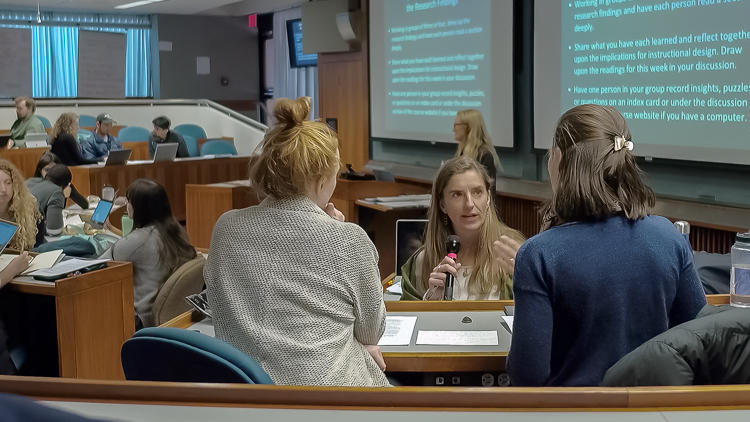A lecturer who acts primarily as a “sage on the stage” for an entire class session will likely struggle to gauge or sustain student attention and energy. By incorporating frequent, purposeful questioning into lectures, instructors can keep students energized and deepen their understanding. Brett Flehinger uses factual, analytical, and overarching questions during his lectures to draw out student voices and check the class’s “temperature.”
Breaking up lecture with frequent questions
Instructor
Brett Flehinger, Lecturer on History
Student Group
Undergraduate
School
Harvard College
Course
American Populisms: From Thomas Jefferson to the Tea Party + Trump
Group Size
38 students
- Be purposeful with your questioning. If you intend to check for understanding, you might ask a factual question, but if your goal is to stimulate critical thinking, ask students a question that requires more analysis.
- It’s not easy to come up with varied, high-quality questions on the fly. Insert analytical, overarching questions into your lecture plan in advance.
- Incorporate wait-time. For the highest-quality ideas and the most robust participation, students need time to process information and think about their answers, which requires the instructor to pause for a few seconds rather than calling on the first raised hand.
- Be clear. Avoid asking multiple questions at once, leading questions, or vague questions.
- Findings from Casteel and Bridges suggest that incorporating more components from seminar-style courses, such as instructor facilitated questions, may increase the amount of information students perceive they have learned (2007)
- Combining content-based questions with lectures was linked to higher student quiz and exam scores (Giers & Kreiner, 2009)
- Elder and Paul argue that thinking is driven by questions and less so by answers. This is because questions can be used to express problems and delineate issues whereas when an instructor provides answers, this can stop student thought processes (2010).
- In a study to investigate the role of self-explanation in understanding, students were tested for their knowledge on the circulatory system. Students in one group were prompted to self-explain after reading a section on the circulatory system, whereas a students in a second group were asked to read the passaged twice. The self-explanation group had a greater gain in understanding from pre-test to post-test suggesting that self-explanation can facilitate learning (Chi, 1994).
- The Chicago Center for Teaching at the University of Chicago has a comprehensive toolkit to help instructors with ask “Asking Effective Questions”
- The Christensen Center for Teaching and Learning at Harvard Business School provide best practices in “Questioning, Listening, and Responding.” At the bottom of the page, Professor David Garvin reflects on how he listens at four levels to his students’ responses.
- The Teaching Center at Washington University in St. Louis shares numerous tips for “Asking Questions to Improve Learning”
- In another Instructional Moves video, Bob Kegan and Dan Levy discuss how they employ wait-time after posing questions so students can process information and gain confidence




